by Pinchas Cohen
Key Events
Asian equities soared to their highest levels in a decade this morning, but were hauled down by stocks in China and South Korea. Last week's selloff in Chinese shares, on concerns over regulatory tightening, resumed as early indicators signal the country's economy cooled this month. The Shanghai Composite fell 0.91 percent, taking prices down from near two-year highs to a three-month low.
South Korean shares slid to a week's low, after Morgan Stanley cut its recommendation on Samsung Electronics (KS:005930) to “equal weight” from “overweight”, asserting the memory chip “super cycle” is about to peak, spurring a selloff on shares of the consumer electronics and technology giant. The KOSPI fell 1.43 percent, erasing all of November’s gains.
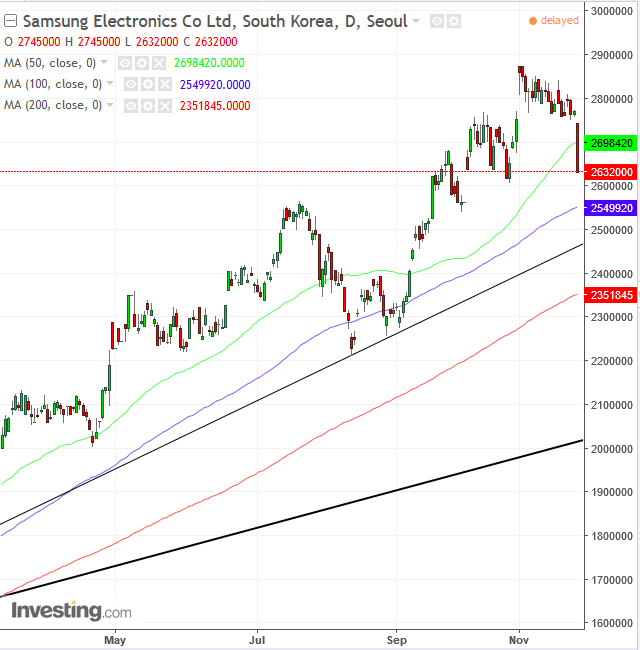
The price of the stock plummeted 5 percent, after the Morgan Stanley report was released. It stated that the major driver of Samsung’s record third-quarter profit of $12.91 billion, announced in October, is peaking, as prices have started to reverse in the fourth quarter. Still, from a technical standpoint, should price bounce off the uptrend line since the US election, surrounded by the 100 dma (blue) and the 200 dma (red), it would demonstrate that investors are likely to extend the uptrend.
Global Financial Affairs
The pessimism contagion spread throughout Asia. Japanese equities bore the added burden of a rising yen, as the highly popular safe haven currency gained the most against the dollar, rendering exports more expensive to other countries and making local stocks more expensive to foreign investors. Spread betters this morning went so far as to put money on the odds that European shares would open lower as well.
And indeed, Europe followed Asia. The Stoxx Europe 600 opened 0.17 percent lower, at 385.97. Despite its rise, the price is still lower than Friday’s closing price. A slump in China-sensitive industrial metal prices is pulling down material shares. Another drag on equities is a rising euro.

Both the single currency and German bunds received a mild boost, as German Chancellor Angela Merkel appears to be nearing the successful formation of a coalition government with the country's SPD party. All that remains are terms. The currency’s rise is very mild. The question is whether a coalition is priced in or investors don’t quite believe it will happen so quickly.
Economic releases from the world’s three largest economies—the US, China and Japan—could provide investors further data to crunch this week in order to formulate an updated outlook on the progress of global growth. The financial media draws a contrast between the bullishness of equity investors on an outlook of continued economic growth and the confidence of bond investors on an outlook of a slowdown to economic growth.
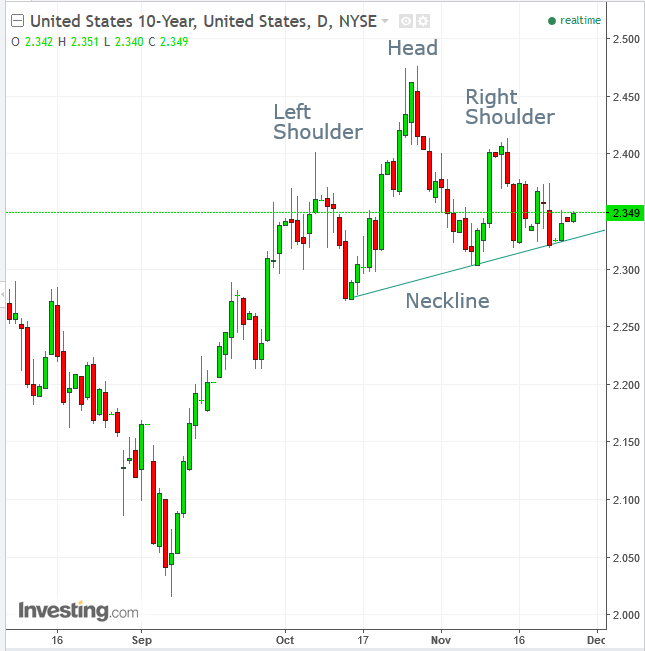
From close perspective that does appear to be the case. While the S&P 500 Index just posted its 54th record for the year, US Treasury yields, including the 10-year note, have meandered. The 10-Y recently began forming a H&S top, something we predicted in this post, forecasting the pattern's development.
Falling yields occur when demand for Treasuries exceeds supply. Rising demand signals that investors don’t believe rates—the yield base—will rise in the visible horizon, just as bond investors don’t believe inflation will escalate, which would allow policy makers to raise rates.
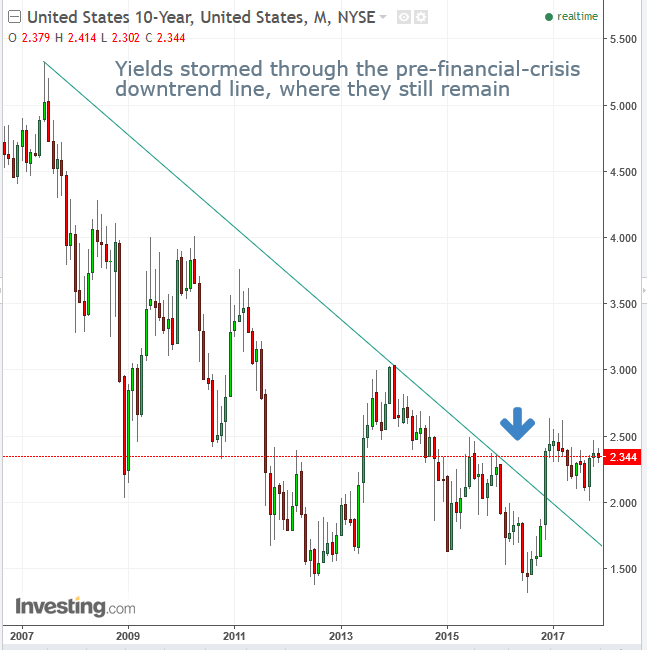
From a broader perspective, however, the picture changes. While yields peaked in December, they nevertheless have not returned to the levels seen before the US election, when animal spirits were roused from their decade-long slumber. When Donald Trump took the White House by storm, risk-on returned to markets. Treasury yields blasted through a downtrend line since June 2007. Currently they remain well above that downtrend line. In fact, yields on 10-year Treasuries are up 26 percent since the US election, even after the fall from the December peak.
Whatever the argument between equity and bond investors—if there even is one, the current slide in Asian equities is likely profit-taking, after the region's major indices reached decade highs, as well as the prospect of a week packed with event risks. Specifically, the possibility of tax reform and OPEC assertiveness have provided equity bulls with a windfall. This week’s Senate vote on a potential tax bill and OPEC's Vienna meeting could be dual catalysts for additional decade-high rallies in Asia..or possible additional declines.
OPEC and Russia, a partner in the oil production quota deal, have crafted the outline of an agreement to extend curbs to the end of next year.
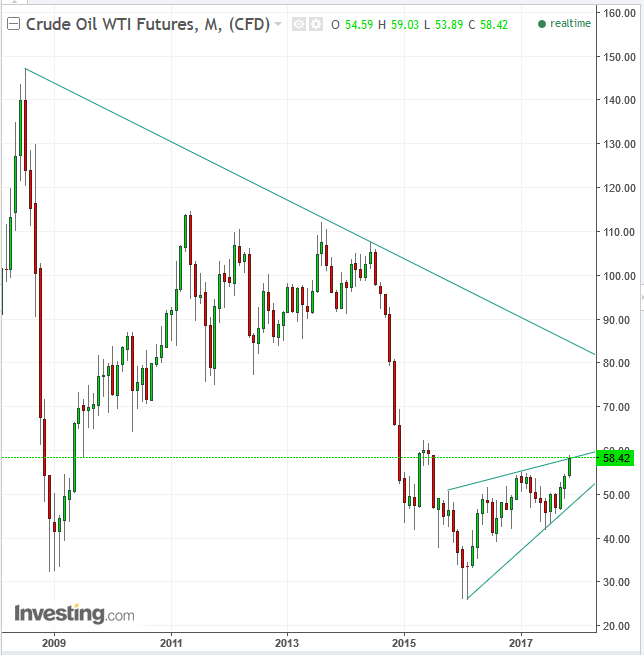
In early November we wrote that the price of oil would remain pressured under $60. Although the long-term downtrend line since July 2008 would be met only at the $80 level, per the current angle, the price has been trading within a bearish “rising wedge” since October 2015.
The pattern consists of two parallel lines, representing the buyers (lower line) and sellers (upper line). While the rising line suggests demand exceeds supply—and that both buyers and sellers agree that prices should rise, as they are both willing to buy and sell at ever rising prices—the disproportionately sharper rise on the demand line versus the supply line suggests the demand is irrational and therefore unsustainable.
On Friday, the price of crude reached $59.03, then retreated to its current $58.41, leaving an upper shadow. Theoretically, the price should now return toward the $54 level, where it may already complete the pattern with a downside breakout.
Today's metals selloff has the potential to turn into a longer slide, should commodities follow a continued Chinese correction down. As we saw last week, commodities are extremely sensitive to the Chinese economy.
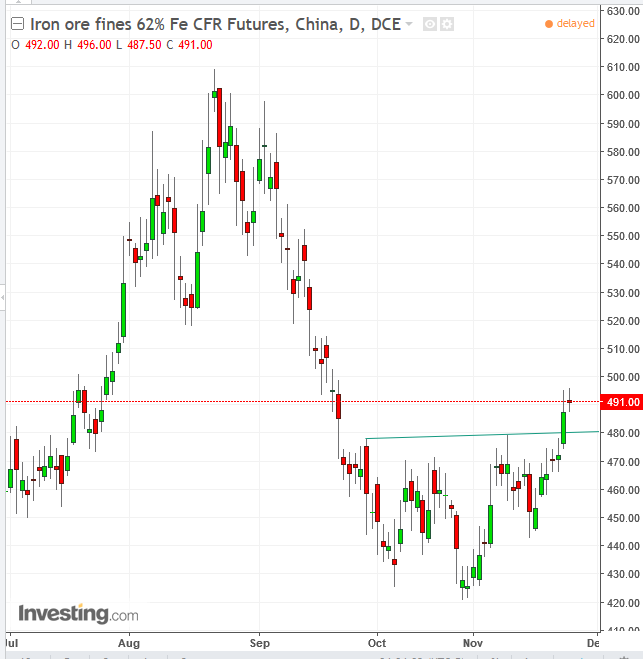
Despite waning economic confidence among China’s sales managers and steel producers in November, commodity indices are still trading within an uptrend. Iron ore , for example, has just broken a two-month high, while completing a bottom.
The South African rand's plunge finally came to a stop this morning. It's downward spiral was triggered by S&P Global cutting the rating of the country’s local-currency debt to junk on Friday, sending the rand 2 percent lower.

The USDZAR pair bounced off the uptrend line since September 6. Despite the dollar weakness, the pair is still above the uptrend line, actually providing an attractive buy, from a risk-reward ratio perspective.
Bitcoin blasted through the $9,000 benchmark during weekend trade and hasn't yet looked back. It was up 17 percent from late Friday's close. Futures trading in the cryptocurrency is tentatively scheduled to begin before the end of the year. It could be a game changer for institutional investors.
Up Ahead
- The US Senate may debate and vote on tax reform as soon as this week, after the House already did so on November 16.
- Fed Chair nominee Jerome Powell's confirmation hearings start on Tuesday. After Janet Yellen warned against raising rates too quickly, will Powell, who favored gradual hikes, slow the path to future increases?
- Yellen will have another opportunity to reiterate her warnings during her testimony to Congress's Joint Economic Committee on Wednesday.
- Minnesota Fed President Neel Kashkari, New York Fed President Bill Dudley, Philadelphia Fed’s Pat Harker are among a plethora of Fed speakers this week.
- The 3-month reprieve from September's government shutdown is now over. President Trump will meet with Democratic and Republican Congressional leaders on Tuesday to see if they can reach an agreement on a Federal spending plan, in order to avert even a partial shutdown and keep the government running after funding runs out on December 8.
- The BOE publishes annual stress tests on Tuesday, alongside its Financial Stability Report looking at the health of U.K. banks.
- Asia’s three largest economies report key data this week. In China, official and Caixin manufacturing PMIs are expected to show mostly steady momentum. Japan industrial production is forecast to have rebounded in October, but CPI may show a sharp divergence between headline and core inflation, Bloomberg Intelligence said. And while third-quarter India GDP is believed to be improving, the impact from the GST has been more severe than anticipated.
- The second print of third-quarter U.S. GDP on Wednesday may be revised higher thanks to consumer spending and inventory accumulation, Bloomberg Intelligence said. Consensus projects a 3.2 percent reading.
- The core PCE deflator, the Fed’s preferred gauge of inflation, is due Thursday and may have ticked up to 1.5 percent, still below the central bank’s target.
- OPEC meets in Vienna on Thursday.
Market Moves
Stocks
- The Stoxx Europe 600 Index decreased 0.3 percent as of 8:17 London time (3:17 EDT), the lowest in more than a week.
- The U.K.’s FTSE 100 declined 0.2 percent to the lowest in a week.
- Germany’s DAX sank 0.4 percent to the lowest in more than a week.
- Japan’s Nikkei 225 fell 0.2 percent.
- The MSCI Asia Pacific Index sank 0.5 percent.
- The MSCI Emerging Markets Index dipped 0.9 percent to the lowest in a week.
- S&P 500 Futures slid 0.1 percent to 2,599.00.
Currencies
- The Dollar Index fell 0.05 percent to the lowest in two months.
- The euro gained 0.1 percent to $1.1944, the strongest in more than two months.
- The British pound dipped less than 0.05 percent to $1.3331.
- The Japanese yen climbed 0.3 percent to 111.20 per dollar, the strongest in more than 10 weeks.
Bonds
- The yield on 10-year Treasuries dipped less than one basis point to 2.34 percent.
- Germany’s 10-year yield declined one basis point to 0.35 percent.
- Britain’s 10-year yield fell one basis point to 1.24 percent, the lowest in almost three weeks.
- Japan’s 10-year yield climbed one basis point to 0.043 percent, the highest in more than a week.
Commodities
